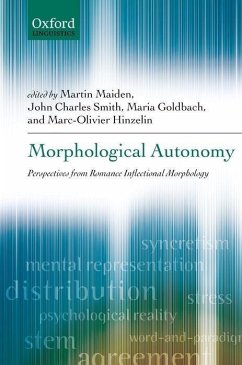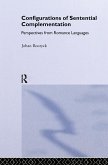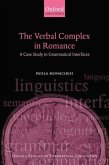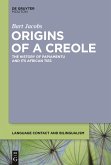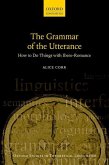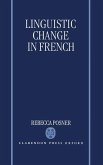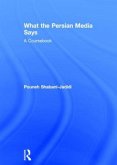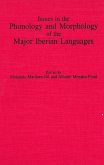Morphological Autonomy
Perspectives from Romance Inflectional Morphology
Herausgeber: Maiden, Martin; Hinzelin, Marc-Olivier; Goldbach, Maria; Smith, John Charles
Morphological Autonomy
Perspectives from Romance Inflectional Morphology
Herausgeber: Maiden, Martin; Hinzelin, Marc-Olivier; Goldbach, Maria; Smith, John Charles
- Gebundenes Buch
- Merkliste
- Auf die Merkliste
- Bewerten Bewerten
- Teilen
- Produkt teilen
- Produkterinnerung
- Produkterinnerung
This book is about the nature of morphology and its place in the structure of grammar. Drawing on a wide range of aspects of Romance inflectional morphology, leading scholars present detailed arguments for the autonomy of morphology, ie morphology has phenomena and mechanisms of its own that are not reducible to syntax or phonology. But which principles and rules govern this independent component and which phenomena can be described or explicated by the mechanisms of the morphemic level? In shedding light on these questions, this volume constitutes a major contribution to Romance historical…mehr
Andere Kunden interessierten sich auch für
![Configurations of Sentential Complementation Configurations of Sentential Complementation]() Johan RooryckConfigurations of Sentential Complementation179,99 €
Johan RooryckConfigurations of Sentential Complementation179,99 €![The Verbal Complex in Romance The Verbal Complex in Romance]() Paola MonachesiThe Verbal Complex in Romance82,99 €
Paola MonachesiThe Verbal Complex in Romance82,99 €![Origins of a Creole Origins of a Creole]() Bart JacobsOrigins of a Creole129,99 €
Bart JacobsOrigins of a Creole129,99 €![The Grammar of the Utterance The Grammar of the Utterance]() Alice CorrThe Grammar of the Utterance130,99 €
Alice CorrThe Grammar of the Utterance130,99 €![Linguistic Change in French Linguistic Change in French]() Rebecca PosnerLinguistic Change in French248,99 €
Rebecca PosnerLinguistic Change in French248,99 €![What the Persian Media Says What the Persian Media Says]() Pouneh Shabani-JadidiWhat the Persian Media Says293,99 €
Pouneh Shabani-JadidiWhat the Persian Media Says293,99 €![Issues in the Phonology and Morphology of the Major Iberian Languages Issues in the Phonology and Morphology of the Major Iberian Languages]() Issues in the Phonology and Morphology of the Major Iberian Languages79,99 €
Issues in the Phonology and Morphology of the Major Iberian Languages79,99 €-
-
-
This book is about the nature of morphology and its place in the structure of grammar. Drawing on a wide range of aspects of Romance inflectional morphology, leading scholars present detailed arguments for the autonomy of morphology, ie morphology has phenomena and mechanisms of its own that are not reducible to syntax or phonology. But which principles and rules govern this independent component and which phenomena can be described or explicated by the mechanisms of the morphemic level? In shedding light on these questions, this volume constitutes a major contribution to Romance historical morphology in particular, and to our understanding of the nature and importance of morphomic structure in language change in general.
Hinweis: Dieser Artikel kann nur an eine deutsche Lieferadresse ausgeliefert werden.
Hinweis: Dieser Artikel kann nur an eine deutsche Lieferadresse ausgeliefert werden.
Produktdetails
- Produktdetails
- Verlag: Oxford University Press
- Seitenzahl: 502
- Erscheinungstermin: 15. Oktober 2011
- Englisch
- Abmessung: 236mm x 160mm x 30mm
- Gewicht: 907g
- ISBN-13: 9780199589982
- ISBN-10: 0199589984
- Artikelnr.: 33252660
- Herstellerkennzeichnung
- Libri GmbH
- Europaallee 1
- 36244 Bad Hersfeld
- gpsr@libri.de
- Verlag: Oxford University Press
- Seitenzahl: 502
- Erscheinungstermin: 15. Oktober 2011
- Englisch
- Abmessung: 236mm x 160mm x 30mm
- Gewicht: 907g
- ISBN-13: 9780199589982
- ISBN-10: 0199589984
- Artikelnr.: 33252660
- Herstellerkennzeichnung
- Libri GmbH
- Europaallee 1
- 36244 Bad Hersfeld
- gpsr@libri.de
Maria Goldbach studied linguistics of the Romance languages at the Universities of Aix-en-Provence and Hamburg. She was assistant professor for the linguistics of Romance languages at the University of Hamburg. Currently, she is a research assistant at the University of Oxford in the research project 'Autonomous Morphology in Diachrony: Comparative evidence from the Romance languages' Marc-Olivier Hinzelin studied Romance and General Linguistics in Hamburg and Lyon 2. He worked as a Research Assistant in Hamburg and Konstanz as well as in the research project 'Autonomous Morphology in Diachrony: Comparative evidence from Romance Languages' in Oxford. He is now Maître de Conférences at the Institut de Linguistique Romane Pierre Gardette at the Université Catholique de Lyon. Martin Maiden is Professor of the Romance Languages at the University of Oxford, the Director of the Research Centre for Romance Linguistics, University of Oxford, and Fellow of Trinity College at Oxford. His main research interests are historical and comparative linguistics of the Romance Languages, especially Romanian and Italo-Romance linguistics, and morphological theory. John Charles Smith has been Fellow and Tutor in French Linguistics at St Catherine's College since 1997. Before returning to Oxford, where he was a student, he held appointments at the Universities of Surrey, Bath, and Manchester. He has also held visiting appointments in Paris, Limoges, Berlin, Melbourne, and Philadelphia. His main field of interest is historical morphosyntax, and he has published widely on agreement, refunctionalization, deixis, and the evolution of case and pronoun systems, with particular reference to Romance. He is Secretary of the International Society for Historical Linguistics, Deputy Director of the University of Oxford Research Centre for Romance Linguistics, and co-editor of the Cambridge History of the Romance Languages. In 2007, he was created chevalier dans l'ordre des Palmes académiques by the French Government, for services to the French language and French culture.
* Introduction
* Part 1: Autonomous Morphology - Corroborations and Challenges
* 1: Stephen R. Anderson: Stress-Conditioned Allomorphy in Surmiran
(Rumantsch)
* 2: Martin Maiden: Morphomes and 'Stress-Conditioned Allomorphy' in
Romanh
* 3: Judith Meinschaefer: Accentual Patterns in Romance Verb Forms
* 4: Paul O'Neill: Morphomes, Morphemes, and Morphological
Segmentation: Evidence From Ibero-Romance
* 5: Sascha Gaglia: Representational Aspects of Morphomic Vowel
variation in Southern Italy
* 6: Andrew Swearingen: The Romance Imperative, Irregular Morphology,
Syncretism, and the Morphome
* 7: Vito Pirrelli, Marcello Ferro, and Basilio Calderone: Learning
Paradigms in Time and Space. Computational Evidence From Romance
Languages
* 8: Rafael Linares: Conjugations and Complex Stems in Spanish Verbs:
Generalization Properties and Priming Effects
* Part 2: Evolution of Stem Allomorphy
* 9: Max Wheeler: The Evolution of a Morphome in Catalan Verb
Inflection
* 10: Maria Goldbach: Metaphony in Portuguese 3rd Class -o(C)C-ir and
-u(C)C-ir Verbs - Comparison With Modern Galician and Mediaeval
Galician-Portuguese
* 11: Ana R. Luis: Morphomic Structure and Loan-Verb Integration:
Evidence From Lusophone Creoles
* Part 3: Interfaces With Syntax or Semantics?
* 12: Xu, Zheng and mark Aronoff: A Realization Optimality-Theoretic
Approach to Full and Partial Identity of Forms
* 13: Marc-Olivier Hinzelin: Syncretism and Suppletion in Gallo-Romance
Verb Paradigms
* 14: John Charles Smith: Variable Analyses of a Verbal Inflection in
(mainly) Canadian French
* 15: Michele Loporcaro: Syncretism and neutralization in the Marking
of Romance Object Agreement
* 16: Anna M. Thornton: Overabundance (Multiple Forms Realizing the
Same Cell): A Non-Canonical Phenomenon in Italian Verb Morphology
* 17: Cinzia Russi: Clitics of Italian Verbi Procomplementari: What are
They?
* 18: Catherine Taylor: Periphrasis in Romance
* 19: Nigel Vincent: Non-Finite Forms, Periphrases, and Autonomous
Morphology in Latin and Romance
* References
* Index
* Part 1: Autonomous Morphology - Corroborations and Challenges
* 1: Stephen R. Anderson: Stress-Conditioned Allomorphy in Surmiran
(Rumantsch)
* 2: Martin Maiden: Morphomes and 'Stress-Conditioned Allomorphy' in
Romanh
* 3: Judith Meinschaefer: Accentual Patterns in Romance Verb Forms
* 4: Paul O'Neill: Morphomes, Morphemes, and Morphological
Segmentation: Evidence From Ibero-Romance
* 5: Sascha Gaglia: Representational Aspects of Morphomic Vowel
variation in Southern Italy
* 6: Andrew Swearingen: The Romance Imperative, Irregular Morphology,
Syncretism, and the Morphome
* 7: Vito Pirrelli, Marcello Ferro, and Basilio Calderone: Learning
Paradigms in Time and Space. Computational Evidence From Romance
Languages
* 8: Rafael Linares: Conjugations and Complex Stems in Spanish Verbs:
Generalization Properties and Priming Effects
* Part 2: Evolution of Stem Allomorphy
* 9: Max Wheeler: The Evolution of a Morphome in Catalan Verb
Inflection
* 10: Maria Goldbach: Metaphony in Portuguese 3rd Class -o(C)C-ir and
-u(C)C-ir Verbs - Comparison With Modern Galician and Mediaeval
Galician-Portuguese
* 11: Ana R. Luis: Morphomic Structure and Loan-Verb Integration:
Evidence From Lusophone Creoles
* Part 3: Interfaces With Syntax or Semantics?
* 12: Xu, Zheng and mark Aronoff: A Realization Optimality-Theoretic
Approach to Full and Partial Identity of Forms
* 13: Marc-Olivier Hinzelin: Syncretism and Suppletion in Gallo-Romance
Verb Paradigms
* 14: John Charles Smith: Variable Analyses of a Verbal Inflection in
(mainly) Canadian French
* 15: Michele Loporcaro: Syncretism and neutralization in the Marking
of Romance Object Agreement
* 16: Anna M. Thornton: Overabundance (Multiple Forms Realizing the
Same Cell): A Non-Canonical Phenomenon in Italian Verb Morphology
* 17: Cinzia Russi: Clitics of Italian Verbi Procomplementari: What are
They?
* 18: Catherine Taylor: Periphrasis in Romance
* 19: Nigel Vincent: Non-Finite Forms, Periphrases, and Autonomous
Morphology in Latin and Romance
* References
* Index
* Introduction
* Part 1: Autonomous Morphology - Corroborations and Challenges
* 1: Stephen R. Anderson: Stress-Conditioned Allomorphy in Surmiran
(Rumantsch)
* 2: Martin Maiden: Morphomes and 'Stress-Conditioned Allomorphy' in
Romanh
* 3: Judith Meinschaefer: Accentual Patterns in Romance Verb Forms
* 4: Paul O'Neill: Morphomes, Morphemes, and Morphological
Segmentation: Evidence From Ibero-Romance
* 5: Sascha Gaglia: Representational Aspects of Morphomic Vowel
variation in Southern Italy
* 6: Andrew Swearingen: The Romance Imperative, Irregular Morphology,
Syncretism, and the Morphome
* 7: Vito Pirrelli, Marcello Ferro, and Basilio Calderone: Learning
Paradigms in Time and Space. Computational Evidence From Romance
Languages
* 8: Rafael Linares: Conjugations and Complex Stems in Spanish Verbs:
Generalization Properties and Priming Effects
* Part 2: Evolution of Stem Allomorphy
* 9: Max Wheeler: The Evolution of a Morphome in Catalan Verb
Inflection
* 10: Maria Goldbach: Metaphony in Portuguese 3rd Class -o(C)C-ir and
-u(C)C-ir Verbs - Comparison With Modern Galician and Mediaeval
Galician-Portuguese
* 11: Ana R. Luis: Morphomic Structure and Loan-Verb Integration:
Evidence From Lusophone Creoles
* Part 3: Interfaces With Syntax or Semantics?
* 12: Xu, Zheng and mark Aronoff: A Realization Optimality-Theoretic
Approach to Full and Partial Identity of Forms
* 13: Marc-Olivier Hinzelin: Syncretism and Suppletion in Gallo-Romance
Verb Paradigms
* 14: John Charles Smith: Variable Analyses of a Verbal Inflection in
(mainly) Canadian French
* 15: Michele Loporcaro: Syncretism and neutralization in the Marking
of Romance Object Agreement
* 16: Anna M. Thornton: Overabundance (Multiple Forms Realizing the
Same Cell): A Non-Canonical Phenomenon in Italian Verb Morphology
* 17: Cinzia Russi: Clitics of Italian Verbi Procomplementari: What are
They?
* 18: Catherine Taylor: Periphrasis in Romance
* 19: Nigel Vincent: Non-Finite Forms, Periphrases, and Autonomous
Morphology in Latin and Romance
* References
* Index
* Part 1: Autonomous Morphology - Corroborations and Challenges
* 1: Stephen R. Anderson: Stress-Conditioned Allomorphy in Surmiran
(Rumantsch)
* 2: Martin Maiden: Morphomes and 'Stress-Conditioned Allomorphy' in
Romanh
* 3: Judith Meinschaefer: Accentual Patterns in Romance Verb Forms
* 4: Paul O'Neill: Morphomes, Morphemes, and Morphological
Segmentation: Evidence From Ibero-Romance
* 5: Sascha Gaglia: Representational Aspects of Morphomic Vowel
variation in Southern Italy
* 6: Andrew Swearingen: The Romance Imperative, Irregular Morphology,
Syncretism, and the Morphome
* 7: Vito Pirrelli, Marcello Ferro, and Basilio Calderone: Learning
Paradigms in Time and Space. Computational Evidence From Romance
Languages
* 8: Rafael Linares: Conjugations and Complex Stems in Spanish Verbs:
Generalization Properties and Priming Effects
* Part 2: Evolution of Stem Allomorphy
* 9: Max Wheeler: The Evolution of a Morphome in Catalan Verb
Inflection
* 10: Maria Goldbach: Metaphony in Portuguese 3rd Class -o(C)C-ir and
-u(C)C-ir Verbs - Comparison With Modern Galician and Mediaeval
Galician-Portuguese
* 11: Ana R. Luis: Morphomic Structure and Loan-Verb Integration:
Evidence From Lusophone Creoles
* Part 3: Interfaces With Syntax or Semantics?
* 12: Xu, Zheng and mark Aronoff: A Realization Optimality-Theoretic
Approach to Full and Partial Identity of Forms
* 13: Marc-Olivier Hinzelin: Syncretism and Suppletion in Gallo-Romance
Verb Paradigms
* 14: John Charles Smith: Variable Analyses of a Verbal Inflection in
(mainly) Canadian French
* 15: Michele Loporcaro: Syncretism and neutralization in the Marking
of Romance Object Agreement
* 16: Anna M. Thornton: Overabundance (Multiple Forms Realizing the
Same Cell): A Non-Canonical Phenomenon in Italian Verb Morphology
* 17: Cinzia Russi: Clitics of Italian Verbi Procomplementari: What are
They?
* 18: Catherine Taylor: Periphrasis in Romance
* 19: Nigel Vincent: Non-Finite Forms, Periphrases, and Autonomous
Morphology in Latin and Romance
* References
* Index

